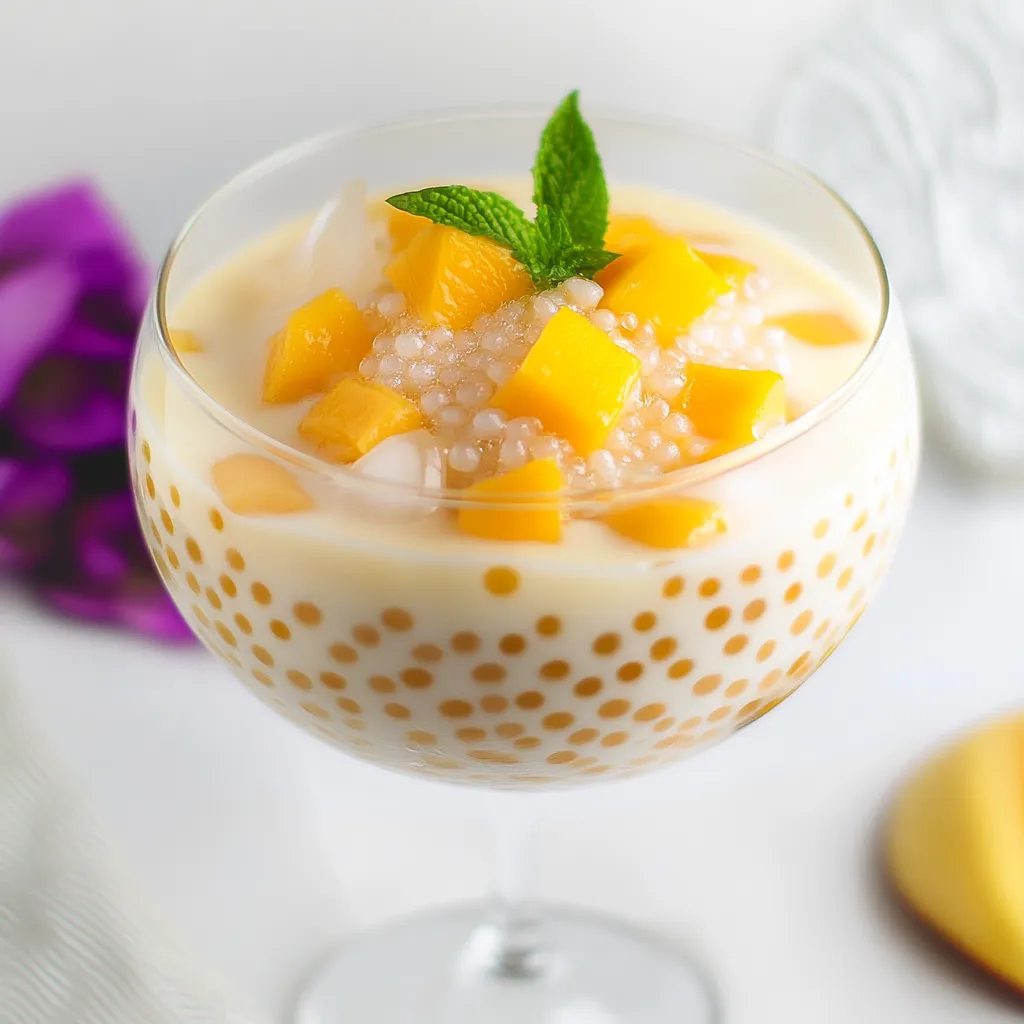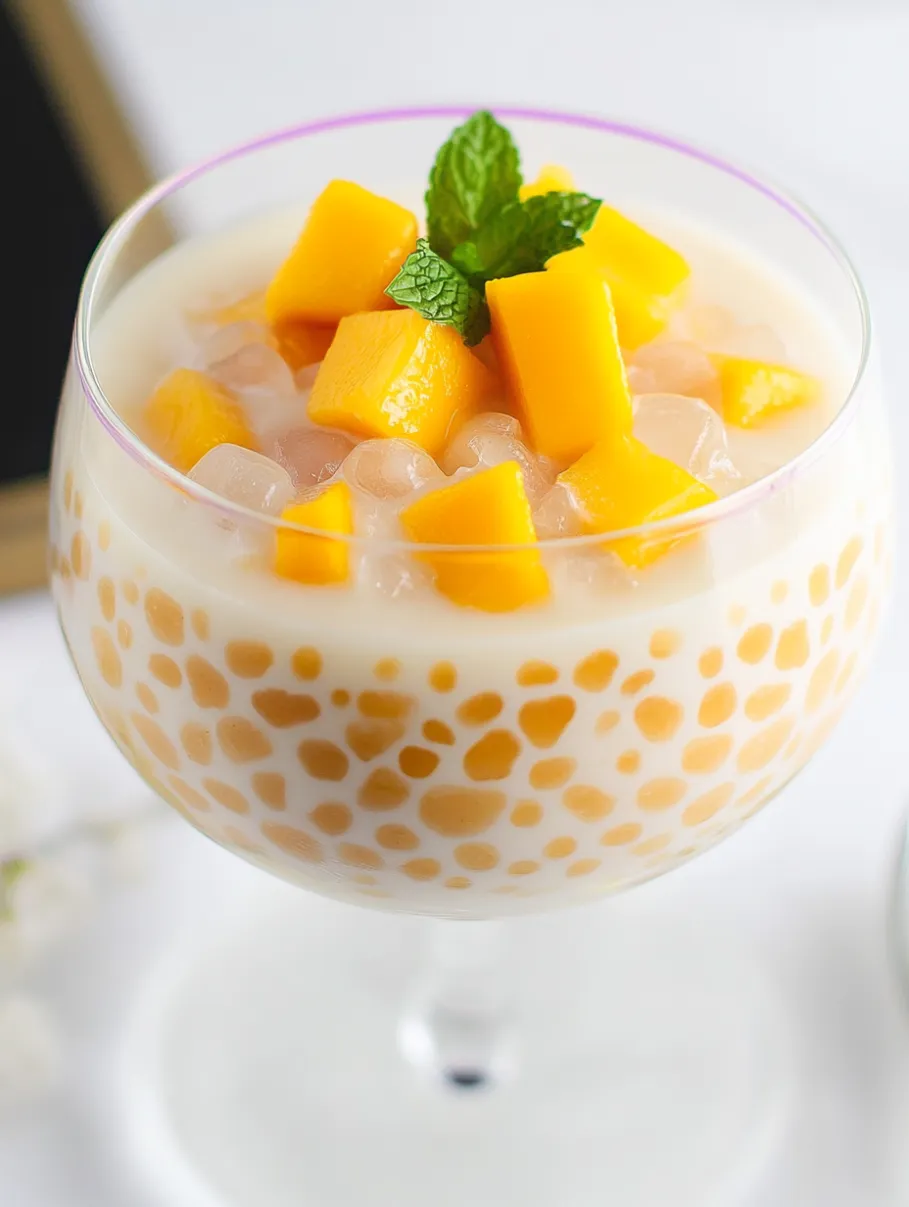 Save
Save
This creamy Mango Sago with Coconut Jelly combines the tropical sweetness of ripe mangoes with chewy tapioca pearls and delightful coconut jelly all swimming in a luscious coconut milk base. The contrasting textures and bright flavors make this Asian dessert the perfect refreshment for warm days when you need something cool and satisfying.
I first discovered this dessert at a small Thai restaurant during a particularly hot summer, and it has become my go-to recommendation whenever friends ask for something unique and refreshing to serve at gatherings. The way the flavors marry together after chilling is absolutely magical.
Ingredients
- Ripe yellow mangoes: Select fruit that yields slightly to pressure and has a sweet aroma at the stem for the best flavor
- Coconut jelly: Adds a fun bouncy texture that contrasts beautifully with the creamy base
- Mini tapioca pearls or sago: These tiny pearls create the signature chewy texture that makes this dessert so addictive
- Sweetened condensed milk: Provides the perfect level of sweetness without needing additional sugar
- Coconut milk: Use full fat for maximum creaminess and authentic flavor
- Water: Helps thin the mixture to the perfect consistency
Step-by-Step Instructions
- Prepare the Coconut Mixture:
- Pour coconut milk into a medium saucepan. Get every last drop of goodness by adding water to the empty can, swirling it around, and adding this coconut-infused water to your saucepan. Add sweetened condensed milk and bring to a gentle boil while stirring occasionally. Once it begins to bubble around the edges, turn off heat immediately to prevent curdling. Allow this mixture to cool completely before assembling your dessert.
- Cook the Tapioca Pearls:
- Bring a medium pot of water to a rolling boil before adding your tapioca pearls. The pearls need gentle simmering for about 10 minutes while you stir occasionally to prevent sticking. The pearls will gradually transform from white to translucent as they cook. After turning off the heat, let them rest covered for another 10 minutes to finish cooking through to the center. Properly cooked pearls should be chewy but not hard in the center.
- Rinse and Drain:
- Using a fine mesh sieve, thoroughly rinse the cooked tapioca under cold running water. This stops the cooking process and removes excess starch that would make your dessert gummy. The pearls should be separated and not sticking together after this step.
- Combine Ingredients:
- In a spacious mixing bowl, gently fold together your diced mango chunks, drained coconut jelly pieces, and the prepared tapioca pearls. Pour in your cooled coconut milk mixture and fold everything together with a gentle touch to avoid breaking up the mango pieces.
- Chill Thoroughly:
- Cover your bowl with plastic wrap and refrigerate for at least 3 hours. This waiting time is essential as it allows the flavors to meld together and the tapioca to absorb some of the sweet coconut flavors. The dessert will also thicken slightly as it chills.
 Save
Save
When I serve this at gatherings, I love watching people's expressions as they take their first spoonful. The combination of textures is always a delightful surprise, especially the playful bounce of the coconut jelly against the creamy background. My Thai friend who taught me this recipe always says the mangoes should be "singing with sweetness" for the best result.
Storage Tips
This dessert keeps well in the refrigerator for up to two days in an airtight container. After that, the tapioca pearls may begin to break down and lose their pleasant chewiness. The mango might also start to release excess juice, making the dessert watery. For the best experience, consume within 48 hours of preparation. If you need to prepare components ahead of time, keep the coconut milk mixture separate from the fruits and tapioca until a few hours before serving.
Fruit Variations
The beauty of this recipe lies in its versatility. While mango creates the classic version, you can experiment with seasonal fruits to create your own variations. Ripe strawberries provide a beautiful color contrast and tangy sweetness. Lychee or longan offer an authentic Asian twist with their floral notes. Pineapple chunks bring bright acidity that cuts through the richness of the coconut milk. For a modern fusion approach, try kiwi and blueberries for a vibrant presentation. Whatever fruit you choose, ensure it is perfectly ripe for the best flavor experience.
Serving Suggestions
Present this dessert in clear glasses to showcase all the beautiful components layered together. For a more substantial offering, serve in bowls with additional fresh fruit on top and a light sprinkle of toasted coconut flakes. On particularly hot days, add a small scoop of coconut ice cream or a few ice cubes just before serving. This dessert pairs wonderfully with a small plate of butter cookies or almond cookies on the side for textural contrast. For special occasions, garnish with a mint leaf and a tiny umbrella for a tropical vacation vibe.
Frequently Asked Questions About Recipes
- → Can I use other fruits instead of mango?
Yes, you can substitute mangoes with strawberries, peaches, or any fruit of your choice.
- → What can I use instead of coconut milk?
You can use regular milk, half and half, or coconut cream thinned out with a bit of water.
- → How long can I store this dish?
It's best consumed within two days. Keep it refrigerated to maintain freshness.
- → How do I prevent the sago from sticking?
Rinse the cooked sago under cold water after draining to remove excess starch and keep them from sticking together.
- → Can I serve this with ice?
Yes, adding ice can make it even more refreshing on a hot day.
